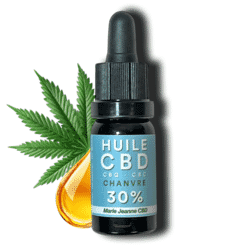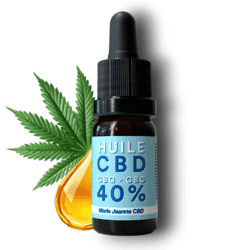How to use CBD oil?

Want to know everything about CBD oil without getting lost in technical details? Our simple and clear guide reveals how to choose, dose, and store your cannabidiol oil!
What is Cannabidiol Oil?
Cannabidiol oil, more commonly known as CBD oil, is a booming natural product. Extracted from the cannabis plant, specifically hemp, this oil should not be confused with psychoactive oils from certain cannabis varieties. CBD, or cannabidiol, is one of many cannabinoids present in the plant, but unlike THC (tetrahydrocannabinol), it does not produce a psychoactive effect.
Origin and Manufacturing/Extraction Method
CBD oil is obtained by extracting the flowers, leaves, and stems of the hemp plant. One of the purest and most effective methods for extracting CBD is the cold-pressing technique. This extraction method yields a cold-pressed CBD oil that preserves the quality and integrity of the active compounds in hemp, ensuring an oil of the highest possible quality.
Different Types of Molecules
CBD oil is a complex mixture of natural compounds extracted from hemp. Understanding these components is essential to choose the oil best suited to your needs:
- CBD (cannabidiol): Cannabidiol is the most abundant non-psychoactive component in hemp. Known for its chemical stability and resistance to decomposition in various forms, CBD is often studied for its potential in various applications, without altering the user's mental or physical state.
- CBG (cannabigerol): CBG is less known but gaining interest for its unique properties. As the "mother molecule," it is the precursor to many other cannabinoids, including CBD. Although in lower concentration in the plant, CBG is studied for its potential in various areas, particularly for its action on cannabinoid receptors.
- CBN (cannabinol): CBN forms when THC, the psychoactive compound of cannabis, oxidizes and ages. Unlike THC, CBN does not produce marked psychotropic effects, but it is explored for its distinct properties due to its interaction with the endocannabinoid system receptors.
- Carrier oils (MCT, coconut oil): Carrier oils like MCT or coconut oil are essential for the bioavailability of CBD oil. MCT oil, derived from coconut, is known for its ability to be rapidly metabolized by the body. It is often used for its efficiency in transporting lipophilic compounds like CBD. Additionally, these carrier oils can have their own nutritional benefits, contributing to the overall value of the product.
How to Choose Your CBD Oil?
The choice of CBD oil depends on several factors, including your personal needs, preferences, and intended use. Understanding the differences between types of CBD oils is essential for making an informed choice. It is also important to consider factors such as the CBD concentration, product quality, extraction methods used, and the origin of the hemp. These elements can greatly influence the effectiveness of the CBD oil you choose.
Here is an overview of the three main types of CBD oils available on the market:
Full-Spectrum Oil
Full-spectrum CBD oil contains all the compounds naturally present in the hemp plant. This includes a variety of cannabinoids (CBD, CBG, CBN, ...), terpenes, flavonoids, and low levels of THC (less than 0.2% to comply with legislation in France). The presence of these various compounds allows for what is known as the entourage effect, where the components act in synergy to mutually enhance their effects. This oil is often chosen by those looking to benefit from the full range of natural components of hemp.
Broad-Spectrum Oil
Broad-spectrum CBD oil is similar to full-spectrum oil, but it has undergone an additional process to completely remove THC. It therefore contains a range of cannabinoids, terpenes, and flavonoids, without any THC. This option is ideal for people who want to avoid any ingestion of THC while still benefiting from the entourage effect.
CBD Isolate Oil
CBD isolate is the purest form of cannabidiol, containing only CBD without other cannabinoids or terpenes. This oil is an excellent option for those seeking only the benefits of CBD or who are sensitive to other cannabis components. It is also a preferred choice for those who must avoid THC for personal or professional reasons.
How to Consume CBD Oil?
CBD oil can be consumed in various ways, each with its own benefits. Here are some common methods of consumption, along with concrete examples:
Sublingual Use
- What is it?: Sublingual consumption involves placing a few drops of CBD oil under the tongue. This method allows for rapid absorption of cannabinoids directly into the bloodstream through the membranes under the tongue.
- Usage Example: Place 2-3 drops of CBD oil under your tongue and wait about 60 seconds before swallowing. This method is ideal for a quick and effective effect.
Mixed with Food or Beverages
- What is it?: Incorporating CBD oil into your diet is a pleasant and discreet way to consume it, with effects taking longer to manifest but lasting longer. The oil can be added to various dishes and beverages.
- Usage Example: Add a few drops of CBD oil to your morning smoothie, coffee, or even recipes like dressings or sauces.
Topical Application
- What is it?: CBD oil can be applied directly to the skin. This method is often used to target specific areas of the body.
- Usage Example: Apply CBD oil to areas affected by muscle pain or skin inflammation. Gently massage until the oil is fully absorbed.
In Capsules or Pills
- What is it?: For those who prefer a precise and convenient dose, CBD capsules or pills are an excellent option.
- Usage Example: Take a CBD capsule with a glass of water, ideally during meals. This method is perfect for those seeking a discreet and tasteless consumption.
What Dosage to Choose for Your CBD Oil Based on Use and Dosage?
Here is an overview of the different types of dosages for correctly consuming your CBD oil:
- Micro-dose: Used for mild symptoms or as an introduction to CBD oil.
- Standard Dose: Ideal for moderate issues. This dose is often used for more intense pain and is suitable if you have already consumed and noticed the effects of CBD on you.
- Macro-dose: Used for severe or chronic conditions. These high dosages are generally used under the supervision of a health professional.
| Concentration | Amount of CBD in 10ml | CBD per Drop | Micro-dose (1-2 drops) | Standard Dose (5 drops) | Macro-dose (10 drops) | Max per Day |
|---|---|---|---|---|---|---|
| 10% | 1000 mg | 5 mg | 5-10 mg | 25 mg | 50 mg | 10 drops |
| 20% | 2000 mg | 10 mg | 10-20 mg | 50 mg | 100 mg | 5 drops |
| 30% | 3000 mg | 15 mg | 15-30 mg | 75 mg | 150 mg | 3 drops |
Usage Example for 30% CBD Oil: If you opt for a 10 ml bottle of 30% CBD oil, this means that the bottle contains a total of 3,000 mg of CBD. Considering that a 10 ml bottle contains about 200 drops, each drop of this oil will therefore contain 15 mg of CBD (3,000 mg divided by 200 drops). To achieve a specific daily dosage, say 15 mg (which corresponds to one drop in this case), you would simply take one drop per day. If your goal is to reach a dosage of 30 mg of CBD per day, you should consume two drops of this oil.
Frequency of Use and Contraindications
The frequency of use depends on the desired effect and individual reaction to CBD. Generally, CBD oil can be taken one to three times a day. It is recommended to take the evening dose an hour before bedtime to promote relaxation. However, it is necessary to keep in mind the following points:
- CBD oil can interact with certain medications and is not recommended for pregnant or breastfeeding women. In case of doubt, it is essential to consult a doctor before starting or modifying your CBD regimen. Moreover, in case of adverse reactions, it is advised to reduce the dose or stop using it.
- CBD is not a medicine.
- CBD does not have "recognized" effects by medicine, it should be consumed in moderation.
- CBD can cause drowsiness in case of overdose, it is advised not to consume it before driving.
How to Properly Store Your CBD Oil?
To ensure optimal long-term preservation of your CBD oil, it is advised to follow these points:
- Protect from Light: Light, especially direct sunlight, can degrade cannabinoids and other compounds present in CBD oil.
Practical Tip: Store your CBD oil in its original packaging, often designed to be opaque or in a tinted bottle. Keep it in a dark place, like a cupboard or drawer.
- Maintain a Stable Temperature: Extreme temperatures, whether very hot or very cold, can affect the consistency and quality of the oil.
Practical Tip: Avoid storing CBD oil near direct heat sources, such as windows, heaters, or in areas prone to freezing. A stable room temperature is ideal.
- Avoid Air and Moisture: Humidity can promote the growth of mold and bacteria, which can alter the quality of the oil.
Practical Tip: Do not store your CBD oil in humid places like the bathroom. A dry place, such as a kitchen cabinet, is preferable.
- Seal the Container Tightly: Exposure to air can oxidize the oil, which can decrease its effectiveness.
Practical Tip: Ensure that the cap of your CBD oil bottle is always tightly closed after each use to limit exposure to air. - Check the Expiration Date: Like any product, CBD oil has a limited shelf life. Respect the expiration date indicated on the packaging to ensure that you are using the CBD oil in the best conditions.




